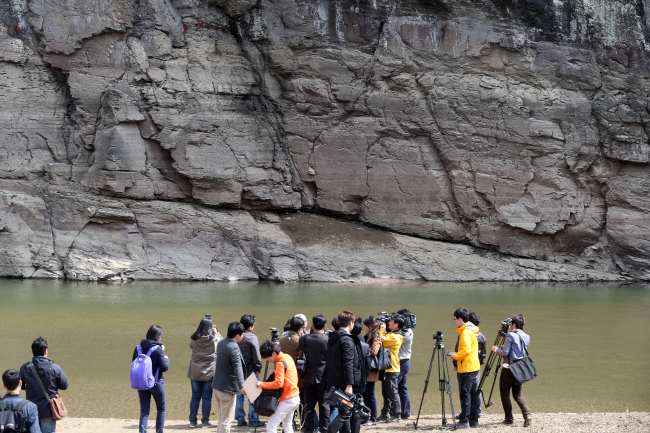Culture officials call for preservation of Bangudae engravings in Ulsan
2013-05-07 19:59
The Cultural Heritage Administration and local authorities at Ulsan are locking horns over the preservation of a group of ancient carvings that are candidates for the UNESCO World Heritage list.Until President Park Geun-hye expressed interest, the engravings on the rock face of Bangudae, located on Daegokcheon Stream cliff in Ulsan, were merely a subject of a decade-long, little publicized issue between cultural experts and local administrators.
But it has become a battlefield where environmentalists, cultural experts, administrators and politicians clash at a national level.
The area of a rock face of Bangudae, measuring 3 meters in height and 10 meters in length, is located on the lower part of a 30-meter cliff facing north. The engraved images include numerous humans, animals, ships, tools and unknown figures.
 |
| A group of journalists and field experts in April observe Bangudae, located on Daegokcheon Stream cliff in Ulsan, where more than 300 petroglyphs are engraved. (Yonhap News) |
 |
| Daegokcheon Bangudae Stream petroglyphs. (CHA) |
Both sea and land animals are depicted as being pregnant, indicating the ancient people’s desire for food and fertility, according to UNESCO. It is also said to be one of the oldest works of art to show whaling by prehistoric man.
The petroglyphs were discovered in 1971, six years after Sayeon Dam was created to secure drinking water for Ulsan and to prevent flooding.
Since the discovery, cultural experts have urged the government to “readjust“ the water level of the reservoir as the water, which covers the carvings for 6-7 months each year, has reportedly damaged the ancient artifacts. Yet the local government has insisted that, for the sake of maintaining sufficient water supply, no changes could be made.
The case resurfaced in March when Park appointed Byun Young-sup, a Korea University professor, to head the Cultural Heritage Administration. Known for her decade-long dedication to the preservation of the petroglyphs, the nomination was interpreted as the new president’s strong desire to conserve the artifacts. Park has reportedly told Cabinet members that she feels “heartache when thinking about Bangudae.”
Byun also told reporters that she could die for the conservation of the petroglyphs. Since Byun’s appointment, the CHA has established a task force for Bangudae and launched a series of projects, including a special exhibition at the National Folk Museum in Seoul and others, to raise public awareness of the issue.
The CHA has publicly requested the Ulsan authorities to lower the water levels from 60 meters to 52 meters.
In response, the Ulsan government suggested erecting an embankment around the petroglyphs to protect them from water.
“What CHA is demanding, readjusting the water level of the reservoir, means we need large-scale construction work on the dam facility. Moreover, it is a great disrespect to Ulsan citizens who may have a shortage of clean drinking water,” Pak Maeng-woo, Ulsan mayor, said on Monday.
The ruling Saenuri Party ― which has unsurprisingly become more attentive to the issue after the president’s comment ― supported the idea. “Until we find a good solution, this could be an interim but feasible settlement,” said Hwang Woo-yea, Saenuri Party chairman.
Still, the CHA stands by its position. The state agency recently announced that it will push for the engravings’ listing on the UNESCO list by 2017. In order to do so, saving the natural environment is mandatory, it said.
“Building an embankment will put a huge strain on the surrounding ecosystem, which will disqualify the site for the UNESCO enlistment,” said Kwon Seok-ju, a CHA official. “About 100 of the 300 engravings are believed have been damaged by water already. We cannot put others at the same risk,” he added.
By Bae Ji-sook (baejisook@heraldcorp.com)


